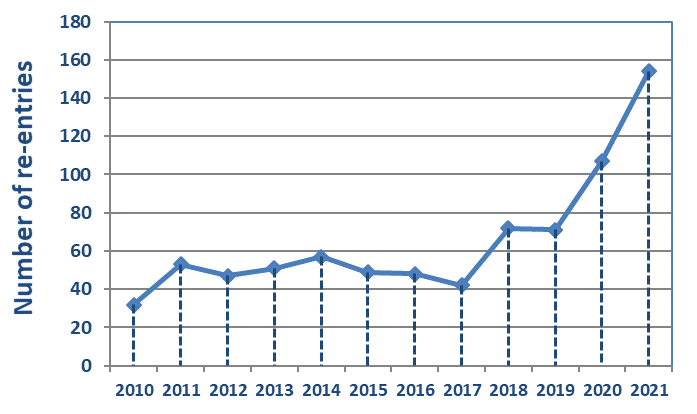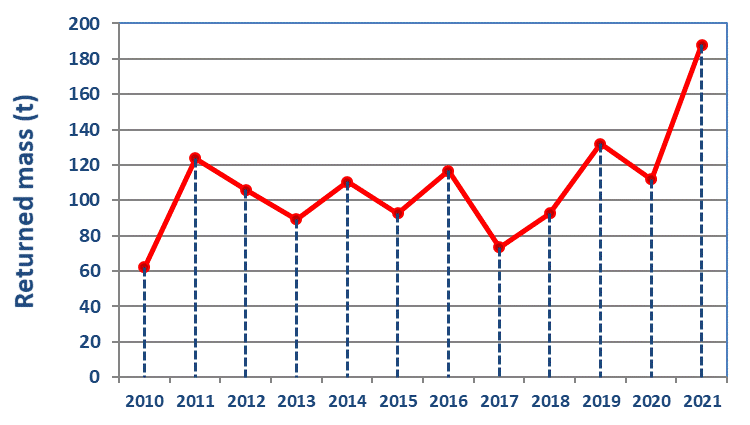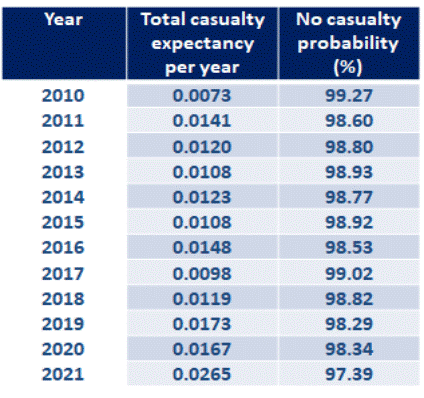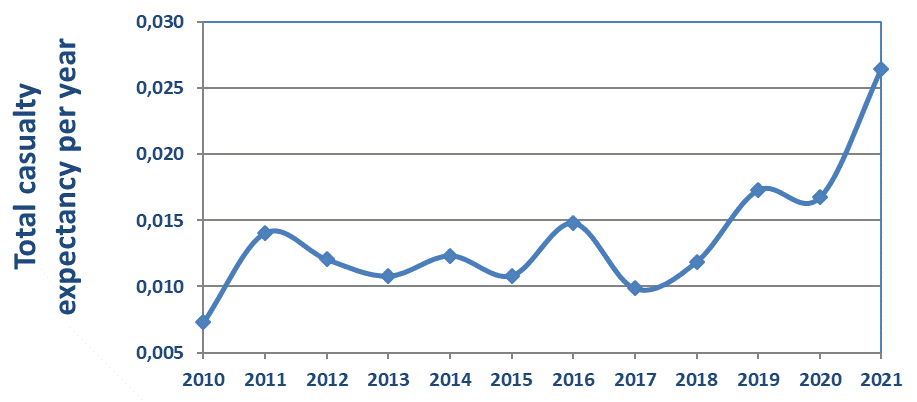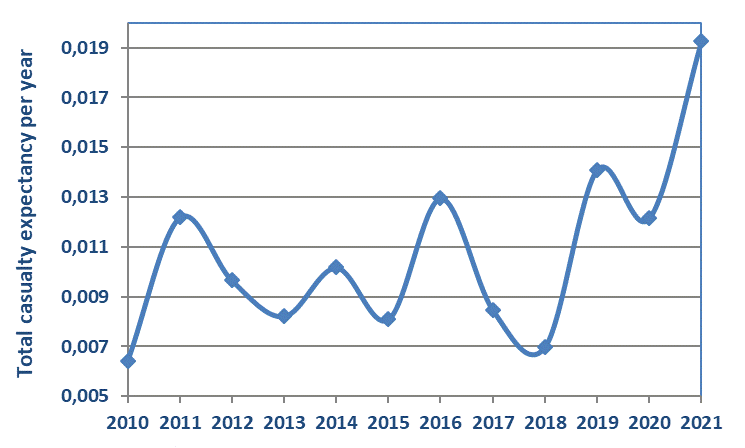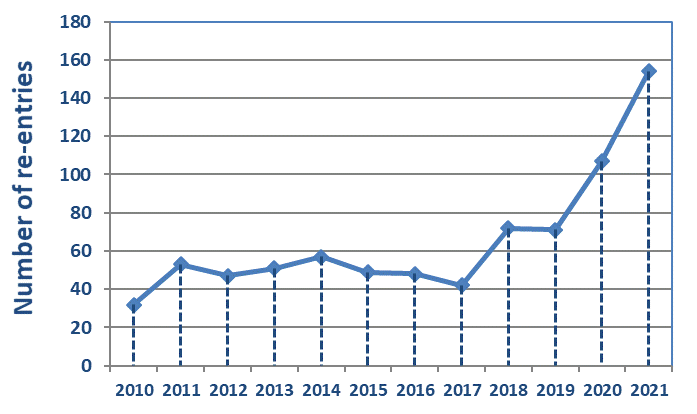The current cumulative annual global casualty expectancy for uncontrolled reentries of spacecraft and orbital stages is of the order of 0.01. Hence, the corresponding individual risk is still extremely low, if compared with the hazards commonly faced in the everyday life, with a probability of being personally injured of the order of 1 in 800 billion per year. However, this risk is increasing, due to the rapid growth of space launch activities and to the rise in world population. Moreover, during the last decades there has been a growing consensus, at the international level, in considering a casualty expectancy of 0.0001 as the risk limit not to be exceeded for any individual uncontrolled reentry, while the introduction of collective risk limits is currently considered for large space systems, like mega-constellations.
In order to assess the current situation in light of these developments, the analyses we have done over the past decade have been revisited and updated to get the present picture of uncontrolled orbital reentries, in terms of number, type, orbit, mass, geographical distribution and estimated casualty risk on ground. 875 intact objects, classified as "large" (i.e. with a radar cross section exceeding 1 square meter) by the 18th US Space Control Squadron, have reentered the Earth's atmosphere without control from the beginning of 2010 to 7 June 2022. Of these, 380 were payloads and 495 orbital rocket bodies. The total returned mass was approximately 1380 metric tons, associated for nearly 79% with rocket bodies and for the remaining 21% with payloads.
Based on what was observed in the period analyzed (12.43 years), the current situation can be summarized as follow. On average, approximately 110 metric tons reenter the atmosphere uncontrolled every year. Objects with a mass greater than 500 kg reenter uncontrolled about every 8 days, those with a mass exceeding 2000 kg reenter approximately every 2 weeks, those with a mass above 4000 kg reenter about every 2 months, and those with a mass greater than 5000 kg reenter approximately 2 times per year. 67 of the reentered rocket bodies had a mass greater than 4000 kg. Concerning the reentries from large satellite constellations, 61 Iridium satellites reentered without control between 2017 and 2020, with a total associated mass of approximately 40 metric tons. Regarding the Starlink mega-constellation, 212 satellites reentered from 2020 to 7 June 2022, with a total associated mass of about 53 metric tons.
During the 12 years from the beginning of 2010 to the end of 2021, the total casualty expectancy at global level from uncontrolled reentries was estimated to be 0.1644, corresponding to a global casualty probability of about 15%. On a yearly basis, the global casualty probability varied between 0.7% (in 2010) and 2.6% (in 2021). In 2021, almost 80% of the uncontrolled reentries of orbital stages had a casualty expectancy exceeding the 0.0001 threshold, while this was true for only 7% of the spacecraft. The total casualty expectancy associated with rocket bodies was 0.0193, corresponding to a probability of having at least one victim on the ground of nearly 2%. Chinese upper stages accounted for nearly 62% of the total risk, Russian/Soviet stages for approximately 18%, and American stages for approximately 14%. For reentering spacecraft, always in 2021, the reentry risk was significantly lower than that represented by rocket bodies, with a total casualty expectancy of 0.0072, corresponding to a probability of having at least one victim of 0.7%. Therefore, in 2021, the risk represented by the uncontrolled reentry of orbital stages was approximately 73% of the total.
The geographical distribution of uncontrolled reentries of large intact objects is a function of launch patterns, mission orbits and end-of-life practices. It is therefore bound to change over time. From September 1992 to December 1996, for example, there was a prevalence of decays in the northern hemisphere (56.5% vs. 43.5%), while from 2004 to 2015 it was found a prevalence of reentries occurring in the southern hemisphere (53.5% vs. 46.5%). In terms of flow per unit area, it was lower than average, approximately one half, above 60° north and south, relatively uniform and close to the average from 30° south to 60° north, and maximum, about 30% higher than average, from 60° to 30° south. Finally, looking at the uncontrolled reentries of rocket bodies in the 15 months between mid-April 2021 and mid-July 2022, 54% occurred in the in the southern hemisphere and 46% in the northern hemisphere.
Authors:
Carmen Pardini (carmen.pardini@isti.cnr.it)
Luciano Anselmo (luciano.anselmo@isti.cnr.it)
Contact point:
Carmen Pardini (carmen.pardini@isti.cnr.it)
Bibliography
1. Pardini, C. and Anselmo, L., RE-ENTRY PREDICTIONS FOR UNCONTROLLED SATELLITES: RESULTS AND CHALLENGES, Proceedings of 6th IAASS Conference "Safety is Not an Option", ESA SP-715, ESA Communications, European Space Agency, ESTEC, Noordwijk, The Netherlands, September 2013
2. Pardini, C. and Anselmo, L., THE UNCONTROLLED REENTRY OF PROGRESS-M 27M, The Journal of Space Safety Engineering, Vol. 3, No. 3, 2016, pp. 117-126, DOI: 10.1016/S2468-8967(17)30005-8
3. Pardini, C. and Anselmo, L., ASSESSING THE RISK AND THE UNCERTAINTY AFFECTING THE UNCONTROLLED RE-ENTRY OF MANMADE SPACE OBJECTS, The Journal of Space Safety Engineering, Vol. 5, No. 1, 2018, pp. 46-62, DOI: 10.1016/j.jsse.2018.01.003
4. Pardini, C. and Anselmo, L., UNCONTROLLED RE-ENTRIES OF SIZABLE SPACECRAFT AND ROCKET BODIES: A POTENTIAL THREAT IN THE AIRSPACE AND ON THE GROUND, 42nd COSPAR Scientific Assembly, PEDAS.1-0012-18, Pasadena (CA), USA, 14-22 July 2018
5. Pardini, C. and Anselmo, L., UNCONTROLLED RE-ENTRIES OF SPACECRAFT AND ROCKET BODIES: A STATISTICAL OVERVIEW OVER THE LAST DECADE, The Journal of Space Safety Engineering, Vol. 6, No. 1, 2019, pp. 30-47, DOI: 10.1016/j.jsse.2019.02.001
6. Pardini, C. and Anselmo, L., THE KINETIC CASUALTY RISK OF UNCONTROLLED RE-ENTRIES BEFORE AND AFTER THE TRANSITION TO SMALL SATELLITES AND MEGA-CONSTELLATIONS, Proceedings of the 11th IAASS International Space Safety Conference "Managing Risk in Space", International Association for the Advancement of Space Safety (IAASS), October 2021, pp. 336-346
7. Pardini, C. and Anselmo, L., THE KINETIC CASUALTY RISK OF UNCONTROLLED RE-ENTRIES BEFORE AND AFTER THE TRANSITION TO SMALL SATELLITES AND MEGA-CONSTELLATIONS, The Journal of Space Safety Engineering, Vol. 9, No. 3, 2022, pp. 414-426, DOI: 10.1016/j.jsse.2022.04.003
8. Pardini, C. and Anselmo, L., HOW THE RE-ENTRY CASUALTY RISK COULD BE IMPACTED BY FUTURE LAUNCH TRAFFIC?, Space Debris Risk Assessment and Mitigation Analysis Workshop, ESA/ESOC, Darmstadt, Germany, 23-24 June 2022
9. Pardini, C. and Anselmo, L., HOW TO ASSESS AND MANAGE THE RISK FROM UNCONTROLLED RE-ENTRIES IN VIEW OF FUTURE DEVELOPMENTS OF SPACE ACTIVITIES, 44th COSPAR Scientific Assembly, PEDAS.1-0026-22, Athens, Greece, 16-24 July 2022
Immagini:

